Sega Mega Drive gamepad
From Sega Retro
Over the span of the Sega Mega Drive's lifecycle, Sega released eight different types of Sega Mega Drive gamepads across its three main regions--NTSC, PAL and NTSC-J.
Types of official gamepads
| Picture | Description |
|---|---|
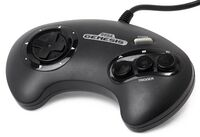
|
Sega Genesis Gamepad: This is the first version of the NTSC gamepad for the Sega Genesis, and as such has a Sega Genesis logo printed on the controller. It features three buttons— |
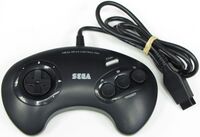
|
Sega Mega Drive Gamepad, PAL Type I: The Sega Mega Drive Gamepad for PAL regions is extremely similar to the Sega Genesis gamepad; however, it has "Mega Drive Control Pad" and the Sega logo printed in lieu of the Sega Genesis logo. |
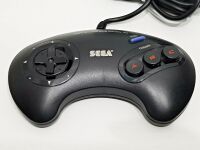
|
Sega Mega Drive Gamepad, JP Type I: Again, the Japanese version of the Sega Mega Drive gamepad is very much like the controllers released in the other two territories, though it has some distinct coloring differences: the |
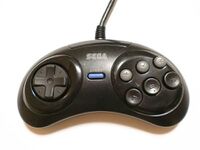
|
Sega Mega Drive Gamepad, JP Type II: Following the success of arcade-to-Mega Drive games such as Street Fighter II, the six-button gamepad was released for a more arcade-like experience. This version of the gamepad featured |

|
Sega Genesis 3 Gamepad: The Sega Genesis 3 Gamepad, which was packed into the Genesis 3 console, is an improved version of the Sega Genesis Gamepad and a near-identical clone of the JP Type II Gamepad. It features six buttons, mode and start; the START button in this release is gray. |

|
Sega Megafire Gamepad: Released exclusively in the PAL region, the Sega Megafire is an official version of the then-popular "turbo" controllers of the time, which offered autofire capabilities. The gamepad offers autofire for |
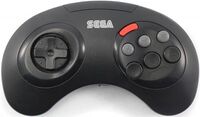
|
Sega Genesis Wireless Gamepad: Released only in the NTSC region, the Wireless Gamepad is a six-button gamepad that interfaces with the Sega Genesis by placing a receiver in the control port to receive RF signals from the wireless gamepad. The pad takes two AA batteries, which are inserted under a lid on the bottom side of the controller. |
Technical Information
The chip inside the gamepad is a 74HC157. This is a high-speed CMOS quad 2-line to 1-line multiplexer. Basically, how this works is there are two inputs ( A and B ) for every output ( Y ). There are four groups like this. There is one select signal for the whole chip. When the select signal is low, the output ( Y ) is the same as input A. When the select signal is high, the output Y is the same as input B. The pinout for the chip is as follows:
| Pin 1 | Select |
| Pin 2 | 1A |
| Pin 3 | 1B |
| Pin 4 | 1Y |
| Pin 5 | 2A |
| Pin 6 | 2B |
| Pin 7 | 2Y |
| Pin 8 | Gnd |
| Pin 9 | 3Y |
| Pin 10 | 3B |
| Pin 11 | 3A |
| Pin 12 | 4Y |
| Pin 13 | 4B |
| Pin 14 | 4A |
| Pin 15 | G (? must be low) |
| Pin 16 | Vcc (+5V) |
All the controls are done with switches. Up is a switch, Down is a switch, etc. Now, I will be referring to the output of these switches later on. The output is usually high when the switch isn't pressed. When the button is pushed, the output goes low. This is accomplished by connecting the output to +5V through a 10k resistor. The button is then attached between the output and ground. It looks like this:
+5V -----/\/\/------+--------- Output
10k |
|
/ |
Ground -----/ -------+
button
(normally open)
The line numbers are determined as follows, looking straight at the plug on the front of the Genesis the numbers are:
1 2 3 4 5 6 7 8 9
| Line 1 | Up output. |
| Line 2 | Down output. These are the only two direct connections. |
| Line 3 | Pin 4 of the chip. Output 1Y. |
| Line 4 | Pin 7 of the chip. Output 2Y. |
| Line 5 | This line carries in +5V. It is connected to the +5V bus line. |
| Line 6 | Pin 9 of the chip. Output 3Y. |
| Line 7 | Pin 1 of the chip. This carries in a select signal from the Genesis. This is a signal which varies rapidly and controls which input goes through the output |
| Line 8 | Ground. This is connected to the Ground bus line. |
| Line 9 | Pin 12 of the chip. Output 4Y. |
Now for the chips pin connections:
| Pin 1 | Line 7 (select) |
| Pin 2 | Ground (1A) |
| Pin 3 | Left (1B) |
| Pin 4 | Line 3 (1Y) |
| Pin 5 | Ground (2A) |
| Pin 6 | Right (2B) |
| Pin 7 | Line 4 (2Y) |
| Pin 8 | Ground (GND) |
| Pin 9 | Line 6 (3Y) |
| Pin 10 | Button B (3B) |
| Pin 11 | Button A (3A) |
| Pin 12 | Line 9 (4Y) |
| Pin 13 | Button C (4B) |
| Pin 14 | Start (4A) |
| Pin 15 | Ground (G) |
| Pin 16 | +5V (Vcc) |